Fighting Jim Crow on the High Seas - Early Days of the Strike
The Fall Strike captured the public’s imagination, and brought the American maritime industry to a standstill. It covered a thousand fronts—from Bath, Maine, to Corpus Christi, Texas—and lasted seventeen weeks. It started with an overwhelming response—over 30,000 seamen struck.
The strikers’ rallies were remarkable. Interracial meetings—in southern towns—in 1936—were unheard of. Black and white seamen eating together in the New York City soup kitchens also reflected the ideals of the new organization. The strikers’ goals were lofty, and equality was high on the list.
First Day of the Fall Strike
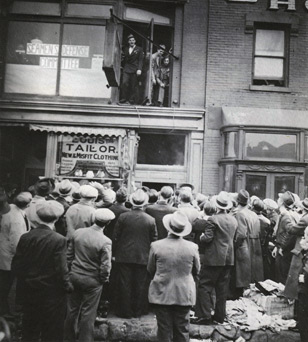 Photograph from Raskin, On a True Course (1967)), courtesy of Tamiment Library, New York University.
Photograph from Raskin, On a True Course (1967)), courtesy of Tamiment Library, New York University.
Strike veteran Rose Martin Jones speaking at Tamiment Library, Oct. 29, 1986:
I came down there from a neighborhood in Brooklyn working for the International Labor Defense which was a civil rights organization for the whole country at that time.
It was a rather large place and when the strike hit, I remember we had a little office there and then a very large meeting room. And we had meetings like every week or so, and people would come, those that were important. And all of a sudden, the next morning, here was this 4,000 men, I mean they had a 24-hour thing going—4,000 men walked in there.
Fortunately, somehow or other—and I don’t think this was done deliberately because no one knew what the strike was going to consist of—or if there was going to be a strike at all—there wasn’t too much warning of it—they had room for a soup kitchen there—everybody who came in there they had something to eat.
There was no haranguing or anything like that going on. They had to go out on picket duty, they went out.
They had two little offices that were closed off—and the rest of it was just one big place. And then in the back was where the soup, the food was given out.
And they were so fed up with the whole idea of all these secret things that had gone on—with these old I.S.U. and Stewards Union with David Grange and all the others, that they didn’t want anybody to ever to go in and shut a door. So they used to talk—Do you remember that—they used to talk about “rank-and-filers”—that was the phrase that was used—and everything was rank-and-file—and you had to leave this door open. So that all the office doors [had to remain open at all times]. There was nothing terrible about it. It was just very funny.
It became a joke after a while. But they were pretty serious about it. They didn’t want anything going on behind closed doors. They didn’t want anybody going in and making any kind of secret things. It worked out very, very well that way.
Joe Curran addressing seamen striking their ships on the first day of the Fall Strike, November 1, 1936. Curran (flanked by two unidentified rank-and-filers) is standing in the open window of strike headquarters, 164 Eleventh Avenue, NYC.
Joe Curran Addressing Strikers
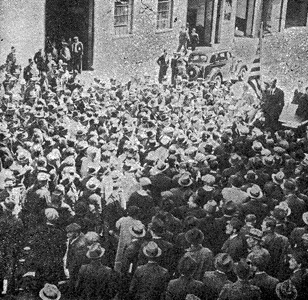 Photograph from I.S.U. Pilot, Nov. 4, 1936, courtesy of Tamiment Library, New York University.
Photograph from I.S.U. Pilot, Nov. 4, 1936, courtesy of Tamiment Library, New York University.
Strikers mass around Curran giving a speech during an impromptu rally on West Street (adjacent to strike headquarters) on the first day of the Fall Strike.
Tallying the Ships on Strike
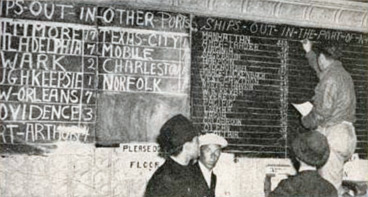 Photograph from Gottlieb, This is the NMU (1956), courtesy of Tamiment Library, New York University.
Photograph from Gottlieb, This is the NMU (1956), courtesy of Tamiment Library, New York University.
During the heady early days of the Fall Strike a daily tally was kept at strike headquarters (on 11th Ave. & 22nd St.)—of ships on strike, and the men registered for strike duty—both in the port of New York and up and down the East Coast to the Gulf of Mexico.
In the first three remarkable days of the Fall Strike, forty-nine ships engaged in sit-down strikes—or their crews were locked out by shipowners fearing sit-down strikes.
A Simple Thing Like Drinking Water
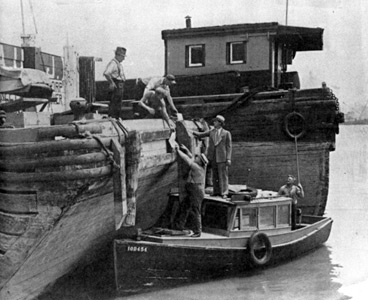 Photograph courtesy of Library of Congress, New York World-Telegram and Sun Collection, 1937.
Photograph courtesy of Library of Congress, New York World-Telegram and Sun Collection, 1937.
By December, strikers had five motor launches patrolling the miles of New York—New Jersey shoreline, inlets, and inland waterways. Organizers often focused on working conditions—including a demand that gangplanks be provided when near shore, so that seamen would have access to fresh drinking water.
Ships’ Officers Picket
 Photograph from Gottlieb, This is the NMU (1956), courtesy of Tamiment Library, New York University.
Photograph from Gottlieb, This is the NMU (1956), courtesy of Tamiment Library, New York University.
Separate craft unions of ships’ deck officers, marine engineers, and radio officers staged walkouts in support of unlicensed personnel on strike.
Mass Picketing
 Photograph from Gottlieb, This is the NMU (1956), courtesy of Tamiment Library, New York University.
Photograph from Gottlieb, This is the NMU (1956), courtesy of Tamiment Library, New York University.
Strike strategists on several occasions drew pickets away from distant piers and concentrated them in front of passenger ships attempting to sail. Although strikers delayed the sailings of a number of passenger ships, no voyages were cancelled. Still, the impact of the Fall Strike was significant: 245 ships, mostly freighters, were tied up for a time during the month of November at East Coast and Gulf ports.
Scabs Not Wanted
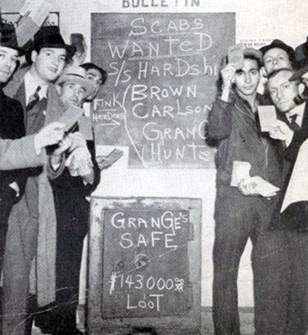 Photograph from Gottlieb, This is the NMU (1956), courtesy of Tamiment Library, New York University.
Photograph from Gottlieb, This is the NMU (1956), courtesy of Tamiment Library, New York University.
On Dec. 14, 1936, a convention of East and Gulf port I.S.U. delegates voted David Grange and all of his fellow I.S.U. officials out of office. Rank-and-filers celebrated by taking over the halls formerly run by the corrupt officials. During the strike Grange had used his I.S.U hall to recruit strikebreakers.
Crowding Round to Sign Up for Picket Duty
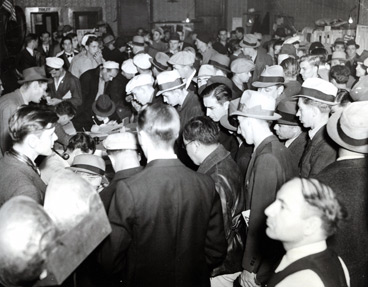 Photograph from Daily Worker/Daily World Photographs Collection, Box 157, folder 22872, courtesy of Tamiment Library, New York University.
Photograph from Daily Worker/Daily World Photographs Collection, Box 157, folder 22872, courtesy of Tamiment Library, New York University.
There was a crush on the second day of the strike as seamen crowded around the desk to register for picket duty on Nov. 2, 1936 in strike headquarters at 164 Eleventh Avenue.
Talking It Over
 Cartoon from the I.S.U. Pilot, Nov. 20, 1936, courtesy of Tamiment Library, New York University.
Cartoon from the I.S.U. Pilot, Nov. 20, 1936, courtesy of Tamiment Library, New York University.
Still a few to be tied up
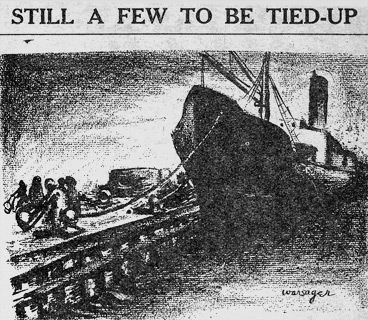 Drawing, apparently by WPA artist Hyman Warsager, from I.S.U. Pilot, Nov. 20, 1936, courtesy of Tamiment Library, New York University.
Drawing, apparently by WPA artist Hyman Warsager, from I.S.U. Pilot, Nov. 20, 1936, courtesy of Tamiment Library, New York University.









